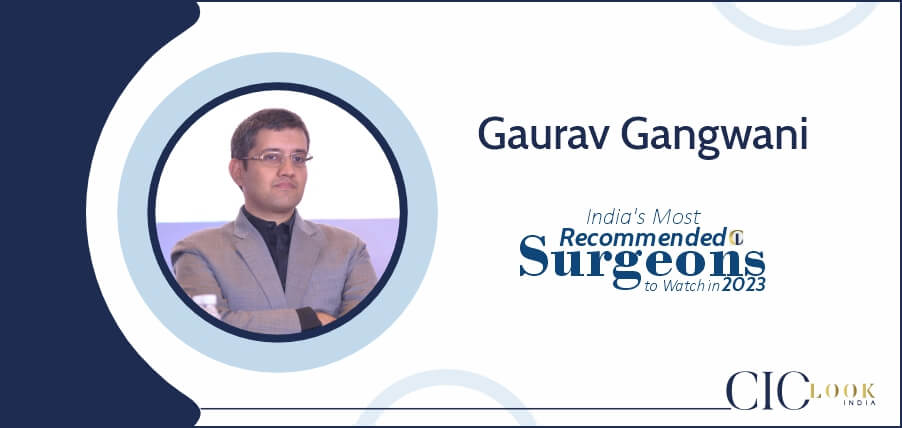Modern healthcare is swiftly advancing. The main aim of current and future treatments is to cure people of their diseases by decreasing associated risks, pain, and time or duration of recovery to the minimum. It is compared to all the other open procedures that have been followed so far.
Intervention Radiology, or IR, is fast emerging as the best medical speciality performing numerous minimally invasive procedures using advanced X-ray, computed tomography, MRI, ultrasound, and real-time visualization techniques. IR is truly futuristic.
It enables expert Intervention Radiologists (Minimally Invasive Vascular Specialists) like Dr Gaurav Gangwani to precisely reach the remotest abnormality in the human body with minimal invasion. Thus, reducing the risks and pain. Further, making the diagnosis, treatment, and entire procedure minimally invasive, non-surgical, and the most accurate ever.
Dr Gaurav says, “I’m a minimally invasive vascular specialist doctor called Interventional Radiologist. I work in various hospitals in Mumbai as a visiting consultant- doing my maximum cases in Lilavati Hospital and Research Institute and also attached to Saifee Hospital, Surana Group of Hospital and Bhaktivedanta Hospital and Research Institute.”
He spoke with CIOLOOK INDIA, where he elaborated in detail on how he is contributing to advancing the IR niche further. Let’s hear it from himself.
Sir, please brief our audience about your Healthcare Organization, its USPs, and how you are currently positioned as one of the most recommended surgeons.
As an Interventional Radiologist, my USP is treating almost 50 medical conditions/diseases or more with minimally invasive techniques via tiny pinhole access. Advantages are that most procedures are performed under local anaesthesia, no scar or cosmetic sequelae, negligible complication risk and rapid recovery.
I treat a lot of common conditions like thyroid nodules in the neck, uterine fibroids, enlarged prostates, varicocele, varicose veins, brain aneurysms, liver cancers and much more with these techniques, medically known as ablation or embolization.
I’m one of the specialist doctors having access to the best infrastructure in Lilavati Hospital, with competent teams and colleagues to help me with the high volume of patients I serve. They consider me one of the top Interventional Radiologists in the country, and I’m appreciated across the globe by my peers.
Tell us more about your offerings and what aspects enable you to stand out in the cutthroat competition.
I’ve established Lilavati Hospital and other hospitals I work in as Centres of Excellence for many interventions like but not limited to microwave ablation for thyroid nodules, embolization for multi-nodular goitre, enlarged prostates, uterine fibroids, varicocele in young males, internal haemorrhoids or piles and venaseal glue based treatment of varicose veins.
Besides these elective conditions, I’m known to rush for emergencies like bleeding or brain strokes requiring embolization or thrombectomy (clot removal technique) respectively. My main USP is my crystal clear explanation of the procedure and all details, including complication risks and recovery to the patient and relatives. I also stand out due to my awareness and educational programs in my clinic and across social media platforms like YouTube, Instagram and Facebook. I’ve over 60 lac views and over 50000 followers/subscribers (by August 2023). This pragmatic, transparent, patient-centric and empathic approach helps me stand out amongst various Interventional Radiologists available. I am one of the first choices when choosing an Interventional Radiologist in Mumbai.
Please brief us about your journey in the Healthcare sector and how you made the healthcare Organization excel in its niche.
I started my medical journey in 2006 when I got selected for my MBBS in the prestigious Topiwala National Medical College and BYL Nair Ch Hospital in Mumbai. After six years, I again cracked my Post Graduation entrance exam and stood 27th across the country to secure a Radiodiagnosis seat in St. Stephens’ Hospital in Delhi.
While doing my DNB in Radiology, I’d already developed an interest in Interventional Radiology and performed more than 300 procedures under supervision before I passed my course in 2016. After that, naturally, I had a strong urge to refine my skill set. I chose to do my super-speciality in Sir Ganga Ram Hospital, Delhi – a centre of excellence for training and fellowship. By 2019, I was an independent consultant at Jaypee Hospital, Noida, where I was part of a team catering to patients (medical tourists) from 19 countries.
Finally, I returned to my native state – Maharashtra and started my practice in Mumbai at Bhaktivedanta Hospital and Research Institute. There, I got inspired to start this awareness program and educational initiative for patient empowerment and got huge success across all social media platforms.
After establishing a centre of excellence in Bhaktivedanta Hospital, Mira Road, I also got associated with various organizations like Surana Hospital, Saifee Hospital and Lilavati Hospital to help patients from different areas benefit from these interventions.
Lilavati Hospital and Research Institute already had an established Interventional Radiology department with the latest state-of-the-art infrastructure and technical support. I added many novel Interventions to the Institute. Like thyroid nodule ablation, thyroid artery embolization, varicocele embolization which I am doing in volumes even revered by countries like the USA.
What professional qualities and values do you think your clients/patients/colleagues admire in you the most?
As explained, I’m known for my transparency in counselling during each interaction with patients and family and my meticulous planning and competent skillset. This is admired by my patients travelling from various regions of the country and abroad. My keen interest in academics and research is appreciated by all my colleagues and peers across the globe.
Being an experienced leader, share your opinion on how adopting modern technologies like AI and ML impacts the Healthcare space and how your organization is adapting to the change.
Adopting modern technology like AI and ML is already having a major impact on our practice. AI-based analysis of perfusion imaging during brain strokes is an ideal example. This software enables Interventional Radiologists to detect strokes within seconds of MRI and CT and predict if a thrombectomy procedure (angiography-based clot removal) would help the patient recover from paralysis. The technology is also being adapted for diagnostic imaging after our interventional procedure of internal chemotherapy and radiation, TACE and SIRT procedures, respectively. The latest AI powered toolbox is the penumbra lightning system which can be used to suck out clot in deep venous thrombosis while causing negligible blood loss, a feat that was virtually impossible earlier.
Considering the current industry scenario, what challenges do you face, and how do you drive your Organization to overcome them?
The healthcare industry’s major challenge is a lack of patient trust or faith in the suggested treatment. Experience from malpractice from few doctors or institutes, media highlighting and exaggerating solitary instances of such circumstances, and superficial medical knowledge from online portals are responsible for this mistrust.
I’ve seldom faced such issues at our organization as my counselling is extremely transparent. I share each detail about the procedure, including animations, to understand the procedure in layman’s language, potential complication risks, cost, recovery period, cosmetic sequelae and chances of recurrence. After sharing details, I’m pragmatic and respectful of patient opinions.
What would be your advice to budding entrepreneurs who aspire to venture into the Healthcare space?
I get multiple calls from budding doctors apprehensive about choosing a medical profession or Interventional Radiology due to fear of competition, AI replacing them and potential occupational hazards. My advice to them is to focus on their passion and goal. Rather than the possible hurdles in the journey. A single-pointed pursuit of academic excellence with a patient-centric approach should be the driving force. All other limitations would be easily bypassed with modern solutions and adaptability.
How do you envision scaling your Organization’s operations and offerings in the future?
The only way to scale our services and expand them to help reach various patients is by training many young Interventional Radiologists to reach many more patients. While continuing efforts for patient awareness about these novel alternatives and options. Once patients are aware and there are enough Interventional Radiologists to provide the service, these procedures will become the standard of care for many diseases and conditions.
Read More: Click Here








